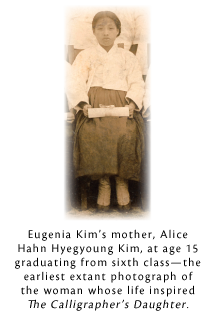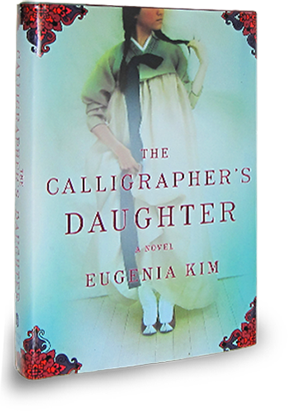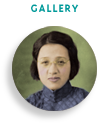


A sweeping debut novel, inspired by the life of the author’s mother, about a young woman who dares to fight for a brighter future in occupied Korea
In early-twentieth-century Korea, Najin Han, the privileged daughter of a calligrapher, longs to choose her own destiny. Smart and headstrong, she is encouraged by her mother—but her stern father is determined to maintain tradition, especially as the Japanese steadily gain control of his beloved country. When he seeks to marry Najin into an aristocratic family, her mother defies generations of obedient wives and instead sends her to serve in the king’s court as a companion to a young princess. But the king is soon assassinated, and the centuries-old dynastic culture comes to its end.
In the shadow of the dying monarchy, Najin begins a journey through increasing oppression that will forever change her world. As she desperately seeks to continue her education, will the unexpected love she finds along the way be enough to sustain her through the violence and subjugation her country continues to face? Spanning thirty years, The Calligrapher’s Daughter is a richly drawn novel in the tradition of Lisa See and Amy Tan about a country torn between ancient customs and modern possibilities, a family ultimately united by love, and a woman who never gives up her search for freedom.
While The Calligrapher's Daughter is a work of fiction, it takes place in a country whose antiquity, often alluded to in the novel, might be unfamiliar to some readers. Korea is one of the oldest unified nation-states in history, and is also one of the most homogeneous societies in the world. Two of Korea’s dynasties, including the most recent Joseon Dynasty* (1392–1910), are among the longest sustained monarchies in world history. Graced with peace, reformation and enlightenment, these monarchies also suffered strife—royal filicide, internecine coups, attempted rebellions, factionalism, invasions and oppression. It is the extraordinary longevity of Korean political, ethnic and cultural continuity that remains a wellspring of the nation’s proud identity.
 Korea’s legendary origin is remarkably pinpointed to a specific day more than 4,300 years ago, October 3, 2333 BCE, and is a mythic saga of a heavenly visitation to a she-bear on a mountain who ultimately gives birth to Korea’s first king, Dangun. In the years leading to the Japanese occupation, the Dangun legend rose to importance as newspapers pitted Korea’s ancient heavenly heritage against the Japanese emperor’s relatively recent divine pedigree in a contest of primacy. But until the modern age, neither country disputed the supremacy and longevity of China.
Korea’s legendary origin is remarkably pinpointed to a specific day more than 4,300 years ago, October 3, 2333 BCE, and is a mythic saga of a heavenly visitation to a she-bear on a mountain who ultimately gives birth to Korea’s first king, Dangun. In the years leading to the Japanese occupation, the Dangun legend rose to importance as newspapers pitted Korea’s ancient heavenly heritage against the Japanese emperor’s relatively recent divine pedigree in a contest of primacy. But until the modern age, neither country disputed the supremacy and longevity of China.
In all of East Asia, China was regarded as the center of the civilized world. Those who were friends were like little brothers who, in exchange for loyalty, symbolic tributes and trade, benefited from Chinese military protection and advances in culture and civilization. Those who were enemies, like the Mongols and the Manchus, were considered barbarians.
Clearly China had a profound influence on the Korean peninsula, but over the centuries Korea transformed those influences into its own distinct advances in literature, art, ceramics, printing, philosophy, astronomy, medicine, and scholarship. Korea invented movable metal type (c. 1230) more than two hundred years before Gutenberg. The world’s first self-striking water clock was constructed in 1434 at the dawn of the Joseon Dynasty, followed by the invention of new sundials, the precision rain gauge and several other astronomical and horologic devices in Korea’s golden age of science (King Sejong’s reign, 1412–50). The most significant invention under King Sejong was the Korean phonetic alphabet, simple enough to be learned by all classes, yet so comprehensive it is still used today. In terms of philosophy, the establishment of Confucianism in the Joseon Dynasty as state policy, religion and social norm was so transformative it has been distinguished as Neo-Confucianism by historians. Also, Korea is the only nation in the world where Christianity first took root without the presence of priests or missionaries, but exclusively as a result of the written word—Bibles, translated into Chinese by Jesuits, that a Korean scholar-official brought home from a diplomatic trip to Beijing in 1631.
In contrast to Korea’s brotherly friendship with China, Korea and Japan shared a long-standing acrimony, exacerbated over the centuries by repeated Japanese pirate raids and the brutal Hideyoshi Invasions in 1592–98. China came to Korea’s defense and that conflict ended in stalemate, but not before Korean Admiral Yi Sun-sin invented the world’s first ironclad ship, the famous turtle ship, and used inventive explosive shells and mobile rocket launchers to repel the Japanese fleet.
The Hideyoshi Invasions initiated an era of wholesale change in the old East Asian order. Japan’s samurai tradition gave way to the Tokugawa shogunate and the beginning of the Edo or modern period of stability (1603–1867) in that country. China’s great Ming Empire fell to the Manchus, a tribal people from Manchuria, who founded the Qing Dynasty, China’s last empire. These key changes fostered Korea’s isolationist policies, and being geographically outside of major trade routes, it became one of the most insulated countries in the world. When the turbulent political climate ebbed in East Asia in the seventeenth century, friendly relations were reestablished, but the animosity between Korea and Japan, and China and Japan was never forgotten.
The 1800s brought wave after wave of Westerners pounding Asia’s shores—Prussians, French, Russians, the British and Americas, an influx that signaled the fall of the Joseon Dynasty. All but Prussia gained footholds in East Asian territory or trade. In particular, a U.S.–forced trade agreement with Japan yielded a new Meiji government (1868) so eager to adopt Western ways that when Japan made its next annual trade tour to Korea, the Korean ministers were shocked to see the Japanese diplomats’ radical change in dress and attitude.
This international influx led to four wars, China’s Boxer Rebellion, and numerous treaties in the latter half of the nineteenth century. In this climate, King Gojong acceded to the throne in 1864 at age twelve. Power devolved to his father, known as the Daewongun, a staunch isolationist. Two years later, Gojong married a fifteen-year-old from the powerful Min clan, which favored modernization and relations with Japan. Bitter power struggles between Queen Min and the Daewongun resulted in waffling policy extremes of isolationism versus Western enlightenment, plus land reform, hefty taxes, growing ideological foment, a major peasant uprising (the Donghak Rebellion), and, overall, a vulnerable Korea. Using gunboat diplomacy, Japan forced Korea’s doors open in 1875 to exclusive trade, and Japanese advisers and military flooded into the Korean court.
Four nations decided the fate of Korea in 1905 without once giving the Yi monarchy or the Korean people an opportunity to voice a single plea for independence. Russia had invaded Manchuria in 1900 and mustered for China, spurring the Russo-Japan War. To protect its interests in China, Great Britain allied with Japan, and in turn acknowledged Japan’s interests in Korea. Both England and America believed Japanese control over Korea was an effective preventative against Russian expansion. President Theodore Roosevelt also saw Japan’s domination of Korea as quid pro quo for U.S. control of the Philippines. And finally, in the American-engineered 1905 Treaty of Portsmouth that ended the Russo-Japan War, Russia pledged not to intercede with Japan’s interests in Korea.
Japan moved quickly. In November 1905 a Japanese statesman, backed by troops, commanded the Korean prime minister to sign the Protectorate Treaty (also called the Treaty of 1905), giving Japan “protective” control over all government offices excluding the new Korean Emperorship. The prime minister refused and was dragged from the palace. Someone was dispatched to find the official seal, which was then affixed to the treaty by Japanese hands and considered accepted.
As Japan’s interests began to spread beyond Korea’s borders, dealing with Emperor Gojong’s diplomatic attempts to regain Korea’s independence and quelching the frequent student protests and popular insurgencies grew burdensome. In 1907 Japan coerced Gojong to abdicate to his son, Sunjong. Then on August 22, 1910, Sunjong was forced to sign the Treaty of Annexation, which made Korea a colony of Japan and ended the long autonomy of the Korean nation. Less than a month later, at the dawn of the thirty-five-year era of Japanese occupation of Korea, Najin was born.
* Yi Dynasty of the Joseon (or Choson) Kingdom, the latter meaning “Land of the Morning Calm.”






